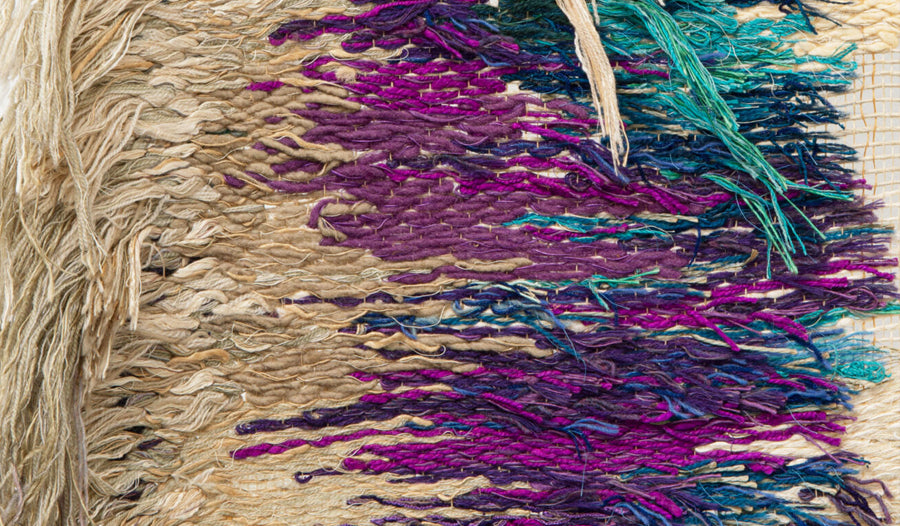
Lenore Tawney: Part One
 Image: Lenore Tawney, Night Bird (detail), 1958. Linen, silk and wool 226.1 x 49.5 cm (89 x 19 1/2 in. Courtesy: The Lenore G. Tawney Foundation, New York, and Alison Jacques, London © Lenore G. Tawney Foundation
Image: Lenore Tawney, Night Bird (detail), 1958. Linen, silk and wool 226.1 x 49.5 cm (89 x 19 1/2 in. Courtesy: The Lenore G. Tawney Foundation, New York, and Alison Jacques, London © Lenore G. Tawney Foundation
Starting today, the first of two exhibitions of work by pioneering textile artist Lenore Tawney (b. 1907, Lorain, Ohio; d. 2007, New York) are being displayed at Alison Jacques, London. Lenore Tawney: Part one, on view during Frieze London, focuses on Tawney’s early work and material innovations; Part Two, which opens in November, will feature rarely seen late work and an installation from the iconic ‘Cloud’ series.
 Tawney was born in Lorain in 1907 and raised on the banks of Lake Erie. In 1957, she left Chicago, her adopted home of 30 years, for New York in the search of ‘a barer life, closer to reality, without all the things that clutter and fill our lives.’ While it took Tawney 50 years to earnestly commit to her artistic practice, her woven negotiations of light, weight and spirit would establish her as a central figure in the fiber art movement of the 1960s.
Tawney was born in Lorain in 1907 and raised on the banks of Lake Erie. In 1957, she left Chicago, her adopted home of 30 years, for New York in the search of ‘a barer life, closer to reality, without all the things that clutter and fill our lives.’ While it took Tawney 50 years to earnestly commit to her artistic practice, her woven negotiations of light, weight and spirit would establish her as a central figure in the fiber art movement of the 1960s.
Tawney first gained notoriety in the early 1960s for her open-warp weavings, which met with acclaim and scepticism from an artworld wary of the encroachment of ‘craft’. Undeterred, Tawney pushed her experimentation further, altering her loom’s reed to startling effect. With a simplicity that belied its daring, this gesture released her warp threads from their structural verticality and introduced to the work an idiosyncratic fluidity. These liberated threads were, in Tawney’s words, ‘expanding, contracting, aspiring forms – sometimes expanding at the edges while contracting in the center.’
 Image: Lenore Tawney, Vespers (detail), 1961. Linen, 208.3 x 53.3 cm (82 x 21 in) Courtesy: The Lenore G. Tawney Foundation, New York, and Alison Jacques, London © Lenore G. Tawney Foundation.
Image: Lenore Tawney, Vespers (detail), 1961. Linen, 208.3 x 53.3 cm (82 x 21 in) Courtesy: The Lenore G. Tawney Foundation, New York, and Alison Jacques, London © Lenore G. Tawney Foundation.
In ‘Lenore Tawney: Part One’, this aspiration is evidenced through towering woven forms such as Shrouded River (1966) and Secret Path (1965), which hang from the gallery ceiling. Vespers (1961) demonstrates a masterly negotiation of negative space. These works demonstrate Tawney’s unique ability to conceive of new possibilities for textile, as well as her ambition to materialise abstract concepts.
The exhibition is also accompanied by a pre-recorded discussion on the life and work of Lenore Tawney, featuring Glenn Adamson (curator, writer and historian); Mark Godfrey (curator); Kathleen Nugent Mangan (executive director, Lenore G. Tawney Foundation); and Harry Thorne (director, Alison Jacques). Watch the video above or on the Alison Jacques website.
Lenore Tawney: Part One will be on display at Alison Jacques, London until 6 November 2021.

1 comment
I bought a large book on Tawney last year. I’m really interested in her work and life, as a weaver myself. I’m so happy to have found this discussion and to have the opportunity to learn more about her and where she fit (or didn’t!) in the world of art and design.